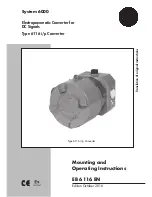
Chapter 9 Appendix
155
Appendix B Brake resistor selection
During the running process of the inverter, if the speed of the controlled motor drops too
fast, or the motor load shakes too fast, its electromotive force will reverse the internal
capacitance of the inverter through the inverter, so that the voltage across the power module
is pumped up, which is easy. Damage to the inverter. The internal control of the inverter will
suppress this situation according to the load situation. When the braking performance does
not meet the customer's requirements, an external braking resistor is needed to achieve
timely release of energy.
The external braking resistor belongs to the energy-consuming braking mode, and its
energy will be completely dissipated in the power braking resistor. Therefore, the power of
the braking resistor and the choice of resistance must be reasonable and effective. The
following are the recommended braking resistor power and resistance values for this drive.
According to the load, the user can change the value appropriately, but it cannot be less than
the minimum required by the inverter.
Inverter power
Recommended resistance value
Minimum resistance
0.75KW-220V
80W 150Ω
80Ω
1.5KW-220V
200W 100Ω
55Ω
2.2KW-220V
200W 70Ω
35Ω
3.7KW-220V
300W 40Ω
25Ω
0.75KW-380V
150W 400Ω
260Ω
1.5KW-380V
200W 300Ω
200Ω
2.2KW-380V
250W 200Ω
150Ω
3.7KW-380V
400W 150Ω
90Ω
5.5KW-380V
500W 90Ω
60Ω
7.5KW-380V
800W 60Ω
47Ω
11KW-380V
1000W 47Ω
36Ω
15KW-380V
1500W 36Ω
27Ω
18.5KW
~
315KW-
380V
Choose according to the requirements and recommendations of the
brake unit
Note
:
When the braking resistor is working, the surface has high voltage and high
temperature. Please consider the safety and flammability of the surrounding
environment when installing.



































